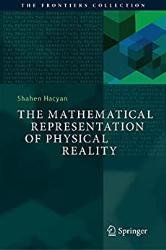The Mathematical Representation of Physical Reality
- Добавил: literator
- Дата: 15-03-2023, 05:20
- Комментариев: 0
 Название: The Mathematical Representation of Physical Reality
Название: The Mathematical Representation of Physical RealityАвтор: Shahen Hacyan
Издательство: Springer
Год: 2023
Страниц: 157
Язык: английский
Формат: pdf (true), epub
Размер: 10.1 MB
This book deals with the rise of mathematics in physical sciences, beginning with Galileo and Newton and extending to the present day. The book is divided into two parts. The first part gives a brief history of how mathematics was introduced into physics—despite its "unreasonable effectiveness" as famously pointed out by a distinguished physicist—and the criticisms it received from earlier thinkers. The second part takes a more philosophical approach and is intended to shed some light on that mysterious effectiveness. For this purpose, the author reviews the debate between classical philosophers on the existence of innate ideas that allow us to understand the world and also the philosophically based arguments for and against the use of mathematics in physical sciences. In this context, Schopenhauer’s conceptions of causality and matter are very pertinent, and their validity is revisited in light of modern physics. The final question addressed is whether the effectiveness of mathematics can be explained by its “existence” in an independent platonic realm, as Godel believed.
Mathematics has been impressively successful in describing a wide variety of phenomena in Nature. This success seems to be natural, but it is not obvious why it should be so; on the contrary, it is a complete mystery to the point that Paul Dirac—who unified relativity with quantum mechanics—came to think that mathematics and reality were two parallel but somehow interconnected worlds. In this regard, Einstein once declared that “the eternal mystery of the world is its comprehensibility” and Wigner, an eminent mathematical physicist, pointed out the “unreasonable effectiveness of mathematics in the natural sciences”.
Mathematical abstractions have been a fundamental step in the development of science, but at the cost of losing the direct perception of Nature which was so dear and familiar to our ancestors. In ancient times, contact with Nature was more immediate and without the mediation of complex devices. Abstract concepts were seldom used. Paradoxically, the world became objective through abstraction, as science found its support in mathematical idealizations.
Nevertheless, the mathematization of science was not successful in all areas. The remarkable advancement of biology, for instance, has shown that a mathematical description does not necessarily bring about a fundamental result, as in the study of inanimate matter. Even in the realm of physics, many natural systems are too elusive to lend themselves to an exact quantitative description. Of course, the difficulties are even more evident in human sciences, where the inescapable intervention of the subject inhibits an objective and quantifiable interpretation. At the very most, statistical data can be accumulated and correlated between them, but without an underlying mathematical theory.
The book aims at readers interested in the history and philosophy of physics. It is accessible to those with only a very basic (not professional) knowledge of physics.
Contents:
Скачать The Mathematical Representation of Physical Reality
Внимание
Уважаемый посетитель, Вы зашли на сайт как незарегистрированный пользователь.
Мы рекомендуем Вам зарегистрироваться либо войти на сайт под своим именем.
Уважаемый посетитель, Вы зашли на сайт как незарегистрированный пользователь.
Мы рекомендуем Вам зарегистрироваться либо войти на сайт под своим именем.
Информация
Посетители, находящиеся в группе Гости, не могут оставлять комментарии к данной публикации.
Посетители, находящиеся в группе Гости, не могут оставлять комментарии к данной публикации.

